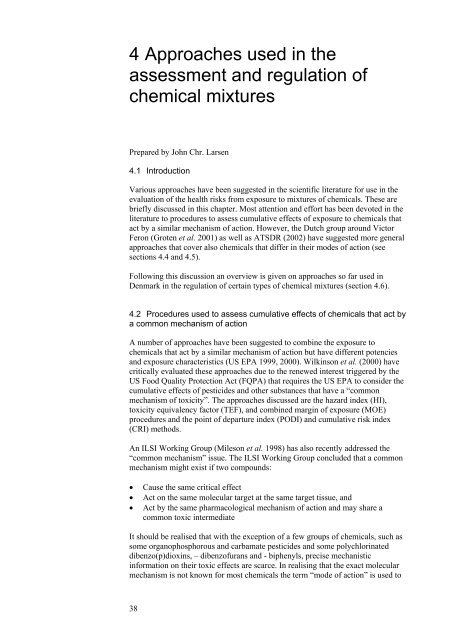Combined Actions and Interactions of Chemicals in Mixtures
Combined Actions and Interactions of Chemicals in Mixtures
Combined Actions and Interactions of Chemicals in Mixtures
Create successful ePaper yourself
Turn your PDF publications into a flip-book with our unique Google optimized e-Paper software.
4 Approaches used <strong>in</strong> the<br />
assessment <strong>and</strong> regulation <strong>of</strong><br />
chemical mixtures<br />
Prepared by John Chr. Larsen<br />
4.1 Introduction<br />
Various approaches have been suggested <strong>in</strong> the scientific literature for use <strong>in</strong> the<br />
evaluation <strong>of</strong> the health risks from exposure to mixtures <strong>of</strong> chemicals. These are<br />
briefly discussed <strong>in</strong> this chapter. Most attention <strong>and</strong> effort has been devoted <strong>in</strong> the<br />
literature to procedures to assess cumulative effects <strong>of</strong> exposure to chemicals that<br />
act by a similar mechanism <strong>of</strong> action. However, the Dutch group around Victor<br />
Feron (Groten et al. 2001) as well as ATSDR (2002) have suggested more general<br />
approaches that cover also chemicals that differ <strong>in</strong> their modes <strong>of</strong> action (see<br />
sections 4.4 <strong>and</strong> 4.5).<br />
Follow<strong>in</strong>g this discussion an overview is given on approaches so far used <strong>in</strong><br />
Denmark <strong>in</strong> the regulation <strong>of</strong> certa<strong>in</strong> types <strong>of</strong> chemical mixtures (section 4.6).<br />
4.2 Procedures used to assess cumulative effects <strong>of</strong> chemicals that act by<br />
a common mechanism <strong>of</strong> action<br />
A number <strong>of</strong> approaches have been suggested to comb<strong>in</strong>e the exposure to<br />
chemicals that act by a similar mechanism <strong>of</strong> action but have different potencies<br />
<strong>and</strong> exposure characteristics (US EPA 1999, 2000). Wilk<strong>in</strong>son et al. (2000) have<br />
critically evaluated these approaches due to the renewed <strong>in</strong>terest triggered by the<br />
US Food Quality Protection Act (FQPA) that requires the US EPA to consider the<br />
cumulative effects <strong>of</strong> pesticides <strong>and</strong> other substances that have a “common<br />
mechanism <strong>of</strong> toxicity”. The approaches discussed are the hazard <strong>in</strong>dex (HI),<br />
toxicity equivalency factor (TEF), <strong>and</strong> comb<strong>in</strong>ed marg<strong>in</strong> <strong>of</strong> exposure (MOE)<br />
procedures <strong>and</strong> the po<strong>in</strong>t <strong>of</strong> departure <strong>in</strong>dex (PODI) <strong>and</strong> cumulative risk <strong>in</strong>dex<br />
(CRI) methods.<br />
An ILSI Work<strong>in</strong>g Group (Mileson et al. 1998) has also recently addressed the<br />
“common mechanism” issue. The ILSI Work<strong>in</strong>g Group concluded that a common<br />
mechanism might exist if two compounds:<br />
• Cause the same critical effect<br />
• Act on the same molecular target at the same target tissue, <strong>and</strong><br />
• Act by the same pharmacological mechanism <strong>of</strong> action <strong>and</strong> may share a<br />
common toxic <strong>in</strong>termediate<br />
It should be realised that with the exception <strong>of</strong> a few groups <strong>of</strong> chemicals, such as<br />
some organophosphorous <strong>and</strong> carbamate pesticides <strong>and</strong> some polychlor<strong>in</strong>ated<br />
dibenzo(p)diox<strong>in</strong>s, – dibenz<strong>of</strong>urans <strong>and</strong> - biphenyls, precise mechanistic<br />
<strong>in</strong>formation on their toxic effects are scarce. In realis<strong>in</strong>g that the exact molecular<br />
mechanism is not known for most chemicals the term “mode <strong>of</strong> action” is used to<br />
38

















